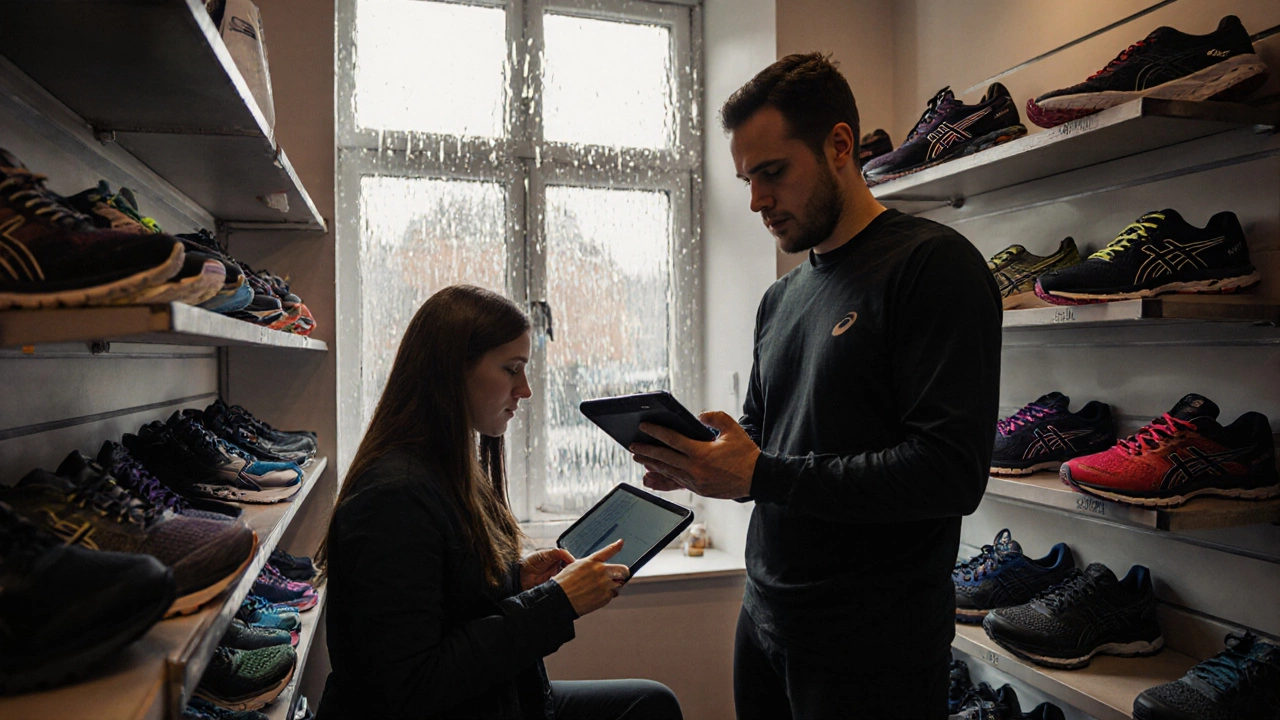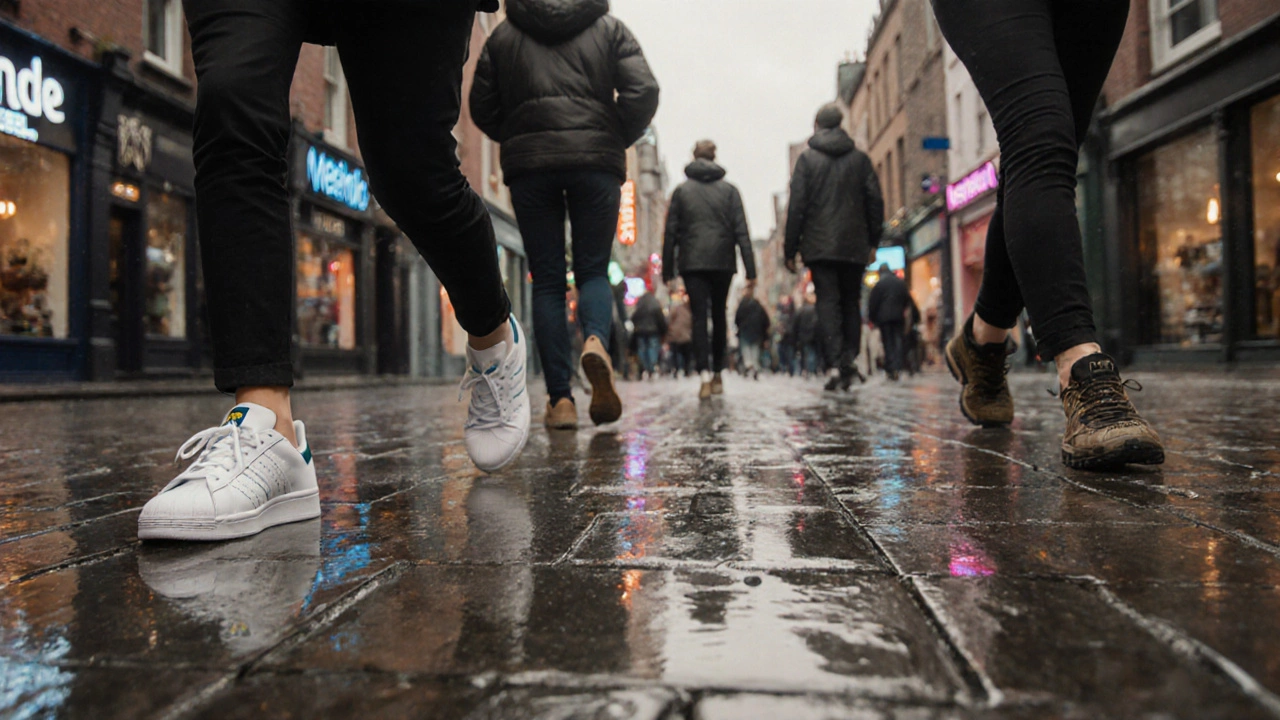When you walk down Grafton Street on a Saturday morning or head out for a brisk jog along the Royal Canal in Dublin, you’ll see plenty of people wearing lightweight, cushioned shoes. But ask someone in Cork or Galway if they’re wearing sneakers or trainers, and you might get a shrug-or a very firm opinion. In Ireland, the words are often used interchangeably, but the difference isn’t just about language. It’s about history, culture, and how we move through our rainy streets and green hills.
What’s in a Name? The Irish Perspective
In Ireland, trainers is the word you’ll hear most often. It’s the term used in shops like Decathlon in Dundrum, in ads on RTÉ, and even in school PE departments across counties. If you walk into Clerys or Primark on O’Connell Street, the sign above the rack will say ‘Trainees’ or ‘Trainers’-never ‘Sneakers.’ That’s not a mistake. It’s tradition. The word trainer comes from the UK, where these shoes were originally designed for athletic training. In Ireland, we inherited that term through decades of cultural exchange with Britain. Meanwhile, sneaker entered the Irish lexicon later, mostly through American pop culture-think Nike Air Jordans, hip-hop videos, and Netflix shows. But even then, it never fully replaced trainers in everyday speech. Ask a teenager in Limerick what they’re wearing, and they’ll say, “My new trainers.” Ask their mum, and she’ll say the same. But if you pull out a pair of Converse Chuck Taylors and ask an American expat living in Temple Bar, they’ll call them sneakers. That’s the split: generational and cultural.Design and Function: Are They Actually Different?
Technically, yes. But not in the way most people think. A sneaker is a type of athletic shoe designed for quiet movement-originally made with rubber soles to let you “sneak” around without making noise. The term was coined in the U.S. in the late 1800s for shoes worn by tennis players and kids playing in schoolyards. Today, most sneakers are casual, lightweight, and built for comfort over performance. A trainer, on the other hand, was designed with sport in mind. It’s built to support your foot during running, jumping, or lateral movement. Brands like Adidas, Asics, and Brooks still make trainers with features like arch support, heel counters, and moisture-wicking linings. You’ll find these in running stores like Runners Need in Belfast or Fit4Life in Limerick City. So here’s the real difference: sneakers are for walking, hanging out, or looking cool. trainers are for moving-running, training, or playing sport. But in Ireland, the line is blurry because most people don’t actually train in them. They wear them because they’re comfortable in the rain.Why the Confusion? Weather, Walks, and Wear
Ireland’s weather doesn’t care about labels. If you’re walking from the LUAS stop to work in Dublin 8, or heading out to the Wicklow Mountains on a Sunday, you need something that’s waterproof, grippy, and won’t fall apart after a month. That’s why Irish shoppers gravitate toward hybrid shoes: the kind that look like sneakers but have the support of trainers. Brands like Clarks and Birkenstock have adapted. Their Cloudsteppers and Arizona models are marketed as “casual footwear,” but they’re worn by people who walk 10,000 steps a day-rain or shine. Meanwhile, Adidas Stan Smiths and Nike Air Force 1s are sold as sneakers, but in Ireland, they’re treated like all-purpose shoes. You’ll see them at the GAA match in Croke Park, in the queue for a pint in Galway, and on the DART to Howth. There’s also the influence of public health. The HSE’s “Walk with a Friend” campaigns and local initiatives like Active Dublin have pushed people to move more. And when you’re walking 5km every day in drizzle, you don’t care if your shoes are called sneakers or trainers-you care if they keep your feet dry.
What to Buy in Ireland? Practical Advice
If you’re shopping for footwear in Ireland, here’s what actually matters:- For daily walking: Go for a pair with a rubber sole, cushioned midsole, and breathable upper. Brands like Clarks, Geox, and Merrell are common in Irish supermarkets and pharmacies.
- For running: Visit a specialist like Runners Need or Pro-Run in Cork. They’ll analyze your gait and recommend a true trainer-not just a fancy-looking sneaker.
- For wet weather: Look for water-resistant materials. Many Irish shoppers swear by Sebago or Timberland boots, but lightweight trainers with a DWR (durable water repellent) coating work fine for light rain.
- For style: If you want to look like you belong on Grafton Street, go for minimalist white trainers. White Adidas Superstars or Converse All-Stars are everywhere. No one calls them sneakers here.
Local Brands and Where to Find Them
Ireland has its own footwear heritage. Clarks has been here since the 1950s, and Clerys used to stock Irish-made shoes before it closed. Today, smaller Irish brands are making a comeback:- Irish Leather Co. in Kilkenny makes hand-stitched walking shoes with Irish suede.
- Galway Footwear offers trainers with recycled ocean plastic uppers-perfect for coastal towns.
- Tipperary Active sells affordable, durable trainers designed for boggy terrain and long walks in the Burren.

What Do You Call Them? The Irish Answer
Here’s the bottom line: In Ireland, you say trainers. Even if you bought them in New York. Even if they’re made in Vietnam. Even if they’re technically sneakers. Language here is shaped by use, not dictionary definitions. You don’t need to overthink it. If you’re buying shoes for walking the cliffs of Moher, commuting on the Luas, or heading to a local GAA match, call them trainers. That’s what everyone else will call them too. And if you’re an American expat trying to fit in? Drop the word sneakers-at least until you’re chatting with someone who’s watched too much Netflix. Then you can say what you like.When It Actually Matters
There’s one time the difference matters: when you’re buying performance gear. If you’re training for the Dublin Marathon, or you’ve got plantar fasciitis from walking too much on cobbled streets, you need a proper trainer. That means:- Heel cushioning to absorb impact
- Arch support for long days
- A sole that grips wet pavement
Final Thoughts
In Ireland, the difference between sneakers and trainers isn’t about labels-it’s about purpose. Most people wear the same pair for everything: work, walking, weekends, and waiting for the bus in the rain. And that’s fine. But if you’re serious about movement-whether it’s running the Phoenix Park or hiking the Wicklow Way-then you need the right tool. Call it what you want. Just make sure it’s built for the job.Because in this country, where the weather changes by the hour and the roads are never flat, your shoes aren’t just fashion. They’re your first line of defense.
